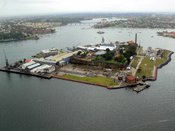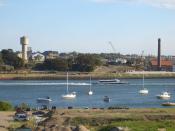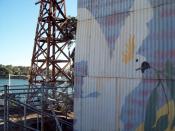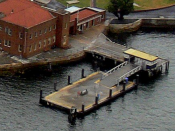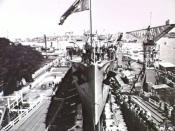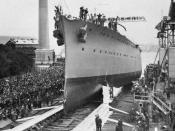Part A
No evidence has been found of Aboriginal use if Cockatoo and until 1839 there was no permanent European settlement there. From the early 1930s the island has been used as a convict prison, quarry, industrial school for girls, a grain storage site, a reformatory and a base for the boys training ships Vernon and Sobraon. Then from the 1850s it was used as a dockyard and serviced ships.
In 1842 there was 323 men imprisoned on the Island. They were forced to construct their own prison buildings, quarried the sandstone of the island for use in public works, including the sea wall of Sydney cove. Very early work also included silo digging in the solid rock.
Prison conditions were very poor on the island. Prisoners were crowded due to the inadequate accommodation. Conditions were so bad that prisoners made a public inquiry into the operation of the prison.
This inquest was considered and constructive. It saw improvement in the administration of the prison but little further development of the prison buildings took place.
Ten years later in July 1869 the end of the penal establishment on Cockatoo Island was approved and so prisoners were transferred to Darlinghurst.
In 1871 an industrial school for girls was set up, with a separate reformatory for girls under 16 who were convicted of a crime. The establishment was renamed 'Biloea' to get rid of its image as the old prison but there was no improvement of the buildings.
A ship called Vernon was purchased by the government for conversion use as a training ship for about 500 wayward and orphaned teenage boys. This was moored to the east of Cockatoo Island. The superintendent of the ship complained that the girls would come down to the ship in a semi-nude state, and swear and throw rocks at the ships. This contaminated the boys' minds.
The establishment was closed down in 1888. In June that year Biloela became a prison again to try easy the overcrowding at Darlinghurst. The prison housed petty offenders, vagrants and prostitutes. The Biloela Gaol was closed in 1908 when the new Long Bay Gaol was completed.
In 1857 Cockatoo Island's first graving dock was built using slow convict labour and it was called the Fitzroy Dock. A larger dock was soon needed if Sydney was to keep up with the rest of the world. Fitzroy dock was getting too small to accommodate large ships.
In 1890 the Sutherland Dock was completed. Shipbuilding and repair work expanded on the island because of the new service buildings and extended wharves.
After 1908 the whole island was transformed into a dockyard. As you can tell the island had been used to build, repair and refit ships and submarines.
The Commonwealth purchased the island from NSW in 1913 to use as a naval dockyard. and was then leased out to 'Cockatoo Island Docks and Engineering Co Ltd'. During the World War 2 the island became the major ship repair facility in the western Pacific.
Decline of shipping in Australia and the size of new container ships made the Dockyard useless. It was therefore closed down in 1992.
Nowadays the island is a tourist attraction, conducting tours around the island. In 2005 it held a music festival in the turbine workshop but the Sydney Harbour Federation Trust are still looking making plans for the future use of Cockatoo Isalnd.
Part B
The study of the site contributed to my understanding of a few aspects of Australian History during the twentieth century. Cockatoo island being Australia's largest dockyard, was mainly used as a dockyard though it is now a tourist attraction. Through our visit there I learnt about the social and ec0onomic changes and issues affecting groups such as women and working Australia.
One of the most surprising things I learnt about Australian history in those times was the poor treatment of convicts. Back then, convicts were forced to do plenty of tedious labour work like building the Fitzroy Dock and their own prison buildings. It wasn't as though after a long hard day of work they were going to even get to sleep in a reasonable bed. In fact they had only a 50cm wide wooden bed to sleep on. I can see how Australia's prison conditions have changed dramatically since the last century.
In the times of the woman's reformatory on the island, it was not yet accepted for women and men to closely intermingle. The boys that were accommodated on the ship Vernon were taught under strict discipline and told that girls were not an important part of their lives. The men and women of the island were also taught different areas of work. Men were taught maritime and survival skills while women were taught how to sew. Women weren't allowed to work for the navy.
Aboriginals also were discriminated against. They weren't even allowed on the island let alone work there.
Federation and its results was something I learnt a bit about. A few years after federation in 1911 the Prime Minister asked the New South Wales government to build a class cruiser and three torpedo boats. Because of the establishment of the Royal Australian Navy in 1913, the commonwealth decided it needed a naval dockyard There they could build their own ships. This taught me how federation played a major role in changes happening in different states.
I also learnt a lot about how Cockatoo Island has helped in World War 1 and World War 2. At Cockatoo Island, they built and repaired many naval warships because it was well equipped. Where would we be now without Cockatoo Island?
It can be inferred that one of the major industry of the twentieth century in Australia was maritime. It can be especially associated with the twentieth century because that was when the two world wars took place. But nowadays it isn't. Maritime was the image of Australia in the early twentieth century.
Overall, I have learnt a few things about Australia's history in the twentieth century. They include the discrimination of different groups like woman, men and Aboriginals as well as how convicts were treated, industrial changes and how Australia got its reputation in the twentieth century. There is a lot you can learn from learning about Cockatoo Island.
Bibliography
Books:
Cockatoo Island- John Jeremy
Reflections on a Maritime City- Interim Sydney Harbour Federation Trust
Websites:
www.cockatooisland.net
www.harbourtrust.gov.au/topics/sitescockatoo.html
